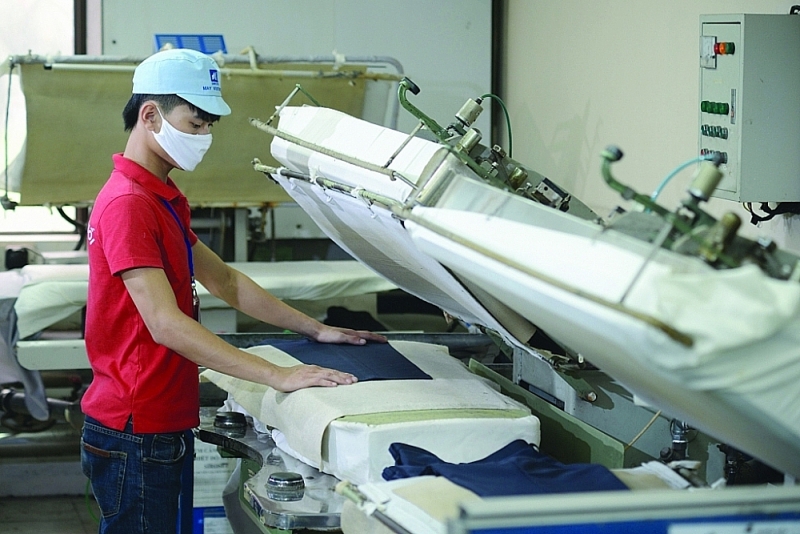 |
| The textile and garment industry is making efforts towards “greening” production, better meeting the requirements and regulations of the import market. Photo: N.Thanh |
Moving from “soft law” to “hard law”
Recently, Sweden and seven other countries, Belgium, Denmark, Finland, Luxemburg, Norway, Spain and Austria, have signed a letter calling on the European Commission (EC) to set a time limit for hazardous chemicals that must be phased out from consumer products.
Sweden and these countries emphasize that goods such as baby products, toys, cosmetics, furniture and clothing are still allowed to contain chemicals that can be harmful to health, especially fetuses and children. Therefore, the proposal for new regulations related to chemical control, which the EC intends to introduce in early 2023, should include a broad ban on these substances to ensure the fullest protection.
Currently, the EU market is increasingly focusing on the development of a circular economy.
Nguyen Hoang Thuy, Head of the Vietnam Trade Office in Sweden, said that at the end of March 2022, the EC presented a proposal for the EU’s new Textile Strategy. At the same time, the EC presented an amendment to the Eco-Design Regulation, which sets forth legal requirements for different groups of products, including clothing and footwear. Textile and garment is one of the first product groups that must comply with eco-design criteria, while the footwear industry must meet the requirements at a later stage.
In the EU, the average consumption of textiles and garments ranks fourth in industries with negative impacts on the environment and climate change; third in water consumption and land use. In addition, there is a tendency to use textiles for a very short time before throwing them away.
“As a result, the EU has changed its approach to sustainability challenges by eliminating “soft laws” as international guidelines in favor of “hard laws” as regulations and legally binding directives,” Thuy said.
Under the Textile Strategy, products must be designed and manufactured to last longer, be repaired, and then reused. The eco-design regulation also includes the development of digital product passports that, in addition to the usual information, must inform consumers of chemical content, repairability and fiber composition. Product-specific information requirements will ensure that consumers are aware of the product’s environmental impact when making a purchase.
The final eco-design regulation must be approved by the European Parliament and Council, expected by the end of 2023, before the first criteria for other product groups are determined, which is expected in 2024.
Efforts to “go green”
According to experts’ assessment, by 2030, textile products in the EU market must have a long life and be recyclable, be made mainly from recycled fibers, not contain harmful substances and be produced to meet social and environmental rights. Producers must take responsibility for their products along the value chain, even when they become waste.
Vietnam’s textile and garment, leather and footwear are two of the products and goods with relatively high export growth to the EU market.
Therefore, Nguyen Hoang Thuy noted, textile and footwear enterprises need to research and innovate according to the above trends and regulations, even to “take shortcuts, catch up” with trends in order to break through exports.
In fact, before the EU market made new moves and stricter regulations, enterprises in the textile and garment industry also actively raised their awareness and made efforts towards “green” production.
Vu Duc Giang, Chairman of the Vietnam Textile and Apparel Association (Vitas), said that the majority of Vietnamese textile and garment enterprises in the supply chain of the textile and garment industry outsourced to big brands have received the requirements of “greening up”.
In production, such as implementing social and environmental responsibility and reducing emissions. Businesses are also transforming production, meeting global commitments and EU legal requirements, such as the Law on Obligations. The German supply chain enterprise due diligence (LkSG) comes into effect in 2023, requiring the identification, prevention, mitigation, and accountability of environmental and social risks throughout the supply chain.
Talking to Customs News, Than Duc Viet, General Director of Garment 10 Corporation said Garment 10 is a leading unit in the industry and has a reputation in the markets. With the program “greening”, on the one hand, enterprises always have to follow the global trends. In addition, businesses are also pressured by their own import customers when they ask for standards on green factories, working environment for employees, reducing polluting emissions, reducing toxic waste.
“Currently, the entire system of Garment 10 factory for export can ensure the requirements of customers. However, with some new certifications, May 10 is also striving. In addition to the green factory, another factor that must be mentioned is green materials. Currently, many customers require that May 10 must use materials of natural origin, recycled materials so as not to exploit many resources and after only 5-10 years of self-degradation after use. That’s what May 10 is focusing on a lot,” emphasized Than Duc Viet.
Similarly, Vuong Duc Anh, Chief of Office of the Board of Directors, Vietnam National Textile and Garment Group (Vinatex) said textile enterprises also have to spend a lot of investment costs to meet the requirements of “greening”, such as investing in rooftop electricity, investing in water saving systems or reusing water in factories.
In particular, for manufacturers of jeans or textile dyeing houses, businesses will have to ensure that chemicals are used safely, have a wastewater treatment process, and save as much water as possible.
